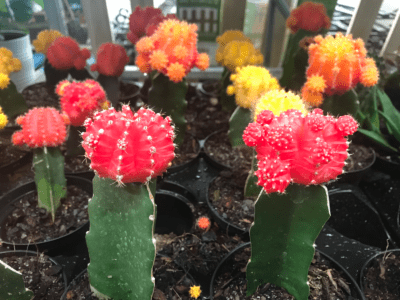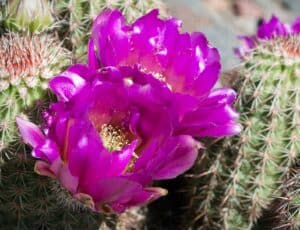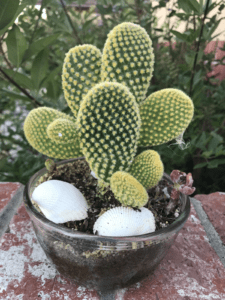This post contains affiliate links.
There are lots of easy to grow cacti that you can grow indoors, so many in fact, that we had a hard time just selecting a few for this list. If you are looking for a few cacti to add to your collection or if you are just getting started, you may want to consider some of these as a starting point.
Moon Cactus (Gymnocalycium mihanovichii)

This is a pretty popular cactus and can be easily found in your local garden centers. It’s colorful and attractive and easy to grow.
It Is actually a combination of two different cacti from South America. The top part comes in different colors like red, orange and yellow and comes from several different cactus varieties and is grafted onto the bottom part, which comes from the hylocereus cactus, which is green.
The bottom part grows faster than the top part, and so the graft will fail after a few years, though it is beautiful while it lasts.
The moon cactus likes bright indirect light and does not need to be watered often, and usually needs no water at all during the winter.
If you are looking for one of these, you can often find them in your local garden centers. You can also find them online, such as with this set of 2 moon cactus plants on Amazon.
Hedgehog Cactus(echinopsis)

The Hedgehog cactus is a cactus that can produce edible fruit (It is even used to create jelly!) and is native to the southern US and Mexico.
These round cacti usually only grow up to around 12 to 18 inches tall and have lots of extremely prickly spines.
It requires lots of sunshine with no shade, so if you are trying to keep it as a houseplant you want to keep it in the sunniest part of your house.
Hedgehog cacti tend to bloom in the middle of spring all the way to early summer, and their flowers can take on a range of various different colors.
They are very tolerant to drought and do not need much water to thrive, so as such they are quite the low maintenance plant and are easy for a novice gardener to grow.
Prickly Pear (Opuntia)

The Prickly Pear cactus, originally found in North and South America and considered a cousin to the bunny ear cactus, is a commonly grown houseplant. There are many varieties of prickly pear, and some can even grow fruit.
They range in size from 6 inches tall up to much larger sizes, especially in the wild and have painful spines or glochids on them. They commonly have yellow flowers, but there are other colors they may have as well.
If given lots of sun and warm temperature, they are easily grown and require little watering, around once every three weeks since they are quite drought resistant. With all of this, they tend to be very low maintenance cacti to grow.
Peanut Cactus (echinopsis, chamaecereus)

Peanut Cactus is a cactus native to Argentina and is easy to grow. Its stems are clumped together and have a finger-like appearance. The stem’s small ribs are lined with white glochids/spines, but these spines are relatively soft compared to those on other types of cacti. (Even so, you should still handle it carefully.) The stems on mature plants can get up to 12” long and around 5 or 6” tall.
This cactus is a low-growing plant that spreads out, making it ideal for either a hanging pot or a standing pot.
It needs lots of sunlight, so be sure to place it in the sunniest part of your home. It likes a period of cooler temperatures in the Wintertime in order to set the buds to bloom. If conditions are right, it will produce reddish-orange flowers in late Spring or early Summer.
This cactus makes an eye-catching display whether it’s blooming or not. Feel free to check this one out on Amazon if you are interested in growing one of these cactus plants.
Christmas cactus and Thanksgiving cactus (Schlumbergera)

The Christmas cactus and Thanksgiving cactus are both in the schlumbergera genus and are often marketed as “holiday cacti” during the Christmas season.
Both of these are best known for the lovely flowers they produce during the months of November and December.
They are actually two different plants: Schlumbergera buckleyi and Schlumbergera truncata. They both look very much alike and are also very easy to grow and maintain.
You will more commonly find Thanksgiving cacti for sale at your local garden center since they hold up better to transportation. You can also find them online at Amazon, like this one here.
They are both tropical cacti and can handle more water than other types of cacti (provided the soil has good drainage). They like bright but indirect light.
Bunny Ears Cactus (Opuntia microdasys)

The Bunny ear cactus has a shape that looks very much like a small version of a prickly pear cactus. They are, in fact cousins, but Bunny ears are smaller, and have a softer appearance from all the white or yellow glochids (spines) covering the pads.
They tend to grow their smaller pads in groups of twos, making them look somewhat like bunny ears. They are also sometimes also called Angel’s wings or Polka-dot cactus.
Bunny ears make an excellent, low-maintenance indoor plant. They will need to be placed in the sunniest part of your house since they need lots of sun to thrive. You can find this one on Amazon; it comes in a 4 inch pot.
If you want to read more about them, especially about how to get them to bloom, we have an article called How to Make Your Bunny Ear Cactus Bloom Indoors
Easter Cactus (Rhipsalidopsis gaertneri)

This is another tropical cactus, similar to the Christmas and Thanksgiving cactus, and is just as easy to grow and maintain. It is also commonly sold in your local garden centers usually starting in early Spring.
The Easter cactus is best known for its showy, star-shaped blooms that occur in the Spring, (around Easter time). The flowers come in a wide range of colors, from red, white, orange, to pink and maybe even more.
All of these holiday cacti that we mentioned are very popular but since they are so similar, it can be hard to know what their differences are – even some garden centers have mislabeled them occasionally. We have an article that can help you know how to tell the difference between them and it is called Differences Between Christmas, Thanksgiving, & Easter Cactus.
This post was written for cactus-central.com and is not permitted to be used on other sites.

